Large Magellanic Cloud
| Large Magellanic Cloud | |
|---|---|
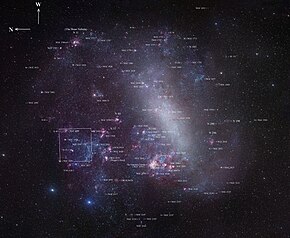 A map of the Large Magellanic Cloud with the brightest features annotated | |
| Observation data (J2000 epoch) | |
| Constellation | Dorado/Mensa |
| Right ascension | 05h 23m 34s[1] |
| Declination | −69° 45.4′[1] |
| Distance | 163,000 light-years (49.97 kpc)[2] |
| Apparent magnitude (V) | 0.13[1] |
| Characteristics | |
| Type | SB(s)m[1] |
| Mass | 1×1010 (excluding dark matter), 1.38×1011[3] (including dark matter). M☉ |
| Number of stars | 20 billion[5] |
| Size | 9.86 kpc (32,200 ly)[1] (diameter; 25.0 mag/arcsec2 B-band isophote)[4] |
| Apparent size (V) | 10.75° × 9.17°[1] |
| Other designations | |
| LMC, ESO 56- G 115, PGC 17223,[1] Nubecula Major[6] | |
The Large Magellanic Cloud (LMC) is a dwarf galaxy and satellite galaxy of the Milky Way.[7] At a distance of around 50 kiloparsecs (163,000 light-years),[2][8][9][10] the LMC is the second- or third-closest galaxy to the Milky Way, after the Sagittarius Dwarf Spheroidal (c. 16 kiloparsecs (52,000 light-years) away) and the possible dwarf irregular galaxy called the Canis Major Overdensity. Based on the D25 isophote at the B-band (445 nm wavelength of light), the Large Magellanic Cloud is about 9.86 kiloparsecs (32,200 light-years) across.[1][4] It is roughly one-hundredth the mass of the Milky Way[11] and is the fourth-largest galaxy in the Local Group, after the Andromeda Galaxy (M31), the Milky Way, and the Triangulum Galaxy (M33).
The LMC is classified as a Magellanic spiral.[12] It contains a stellar bar that is geometrically off-center, suggesting that it was once a barred dwarf spiral galaxy before its spiral arms were disrupted, likely by tidal interactions from the nearby Small Magellanic Cloud (SMC) and the Milky Way's gravity.[13] The LMC is predicted to merge with the Milky Way in approximately 2.4 billion years.[14]
With a declination of about −70°, the LMC is visible as a faint "cloud" from the southern hemisphere of the Earth and from as far north as 20° N. It straddles the constellations Dorado and Mensa and has an apparent length of about 10° to the naked eye, 20 times the Moon's diameter, from dark sites away from light pollution.[15]
History of observation
[edit]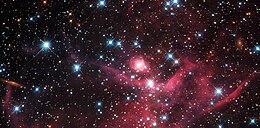
Both the Large and Small Magellanic Clouds have been easily visible for southern nighttime observers well back into prehistory. It has been claimed that the first known written mention of the Large Magellanic Cloud was by the Persian astronomer 'Abd al-Rahman al-Sufi Shirazi (later known in Europe as "Azophi"), which he referred to as Al Bakr, the White Ox, in his Book of Fixed Stars around 964 AD.[17][18] However, this seems to be a misunderstanding of a reference to some stars south of Canopus which he admits he has not seen.[19][20]
The first confirmed recorded observation was in 1503–1504 by Amerigo Vespucci in a letter about his third voyage. He mentioned "three Canopes [sic], two bright and one obscure"; "bright" refers to the two Magellanic Clouds, and "obscure" refers to the Coalsack.[21]
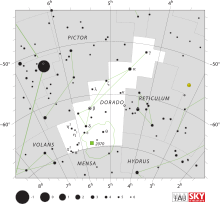
Ferdinand Magellan sighted the LMC on his voyage in 1519 and his writings brought it into common Western knowledge. The galaxy now bears his name.[18] The galaxy and southern end of Dorado are in the current epoch at opposition on about 5 December when thus visible from sunset to sunrise from equatorial points such as Ecuador, the Congos, Uganda, Kenya and Indonesia and for part of the night in nearby months. Above about 28° south, such as most of Australia and South Africa, the galaxy is always sufficiently above the horizon to be considered properly circumpolar, thus during spring and autumn the cloud is also visible much of the night, and the height of winter in June nearly coincides with closest proximity to the Sun's apparent position.
Measurements with the Hubble Space Telescope, announced in 2006, suggest the Large and Small Magellanic Clouds may be moving too quickly to be orbiting the Milky Way.[22]
Astronomers discovered a new black hole inside the Large Magellanic Cloud in November 2021 using the European Southern Observatory's Very Large Telescope in Chile. Astronomers claim its gravity is influenced by a nearby star, which is about five times the mass of the Sun.[23][better source needed]
Geometry
[edit]
The Large Magellanic Cloud has a prominent central bar and spiral arm.[24] The central bar, with a radius of 6,900 light-years (2.13 kpc) and a position angle of about 121°,[25] seems to be warped so that the east and west ends are nearer the Milky Way than the middle.[26] In 2014, measurements from the Hubble Space Telescope made it possible to determine a rotation period of 250 million years.[27]
The LMC was long considered to be a planar galaxy that could be assumed to lie at a single distance from the Solar System. However, in 1986, Caldwell and Coulson[28] found that field Cepheid variables in the northeast lie closer to the Milky Way than those in the southwest. From 2001 to 2002 this inclined geometry was confirmed by the same means,[29] by core helium-burning red clump stars,[30] and by the tip of the red giant branch.[31] All three papers find an inclination of ~35°, where a face-on galaxy has an inclination of 0°. Further work on the structure of the LMC using the kinematics of carbon stars showed that the LMC's disk is both thick[31] and flared,[32][33] likely due to interactions with the SMC.[33] Regarding the distribution of star clusters in the LMC, Schommer et al.[34] measured velocities for ~80 clusters and found that the LMC's cluster system has kinematics consistent with the clusters moving in a disk-like distribution. These results were confirmed by Grocholski et al.,[35] who calculated distances to a sample of clusters and showed that the cluster system is distributed in the same plane as the field stars.
Distance
[edit]
Distance to the LMC has been calculated using standard candles; Cepheid variables are one of the most popular. These have been shown to have a relationship between their absolute luminosity and the period over which their brightness varies. However the variable of metallicity may also need to be taken as a component of this as consensus is this likely affects their period-luminosity relations. Unfortunately, those in the Milky Way typically used to calibrate the relation are more metal-rich than those found in the LMC.[36]
Modern 8-meter-class optical telescopes have discovered eclipsing binaries throughout the Local Group. Parameters of these systems can be measured without mass or compositional assumptions. The light echoes of supernova 1987A are also geometric measurements, without any stellar models or assumptions.[citation needed]
In 2006, the Cepheid absolute luminosity was re-calibrated using Cepheid variables in the galaxy Messier 106 that cover a range of metallicities.[8] Using this improved calibration, they find an absolute distance modulus of , or 48 kpc (160,000 light-years). This distance has been confirmed by other authors.[9][10]
By cross-correlating different measurement methods, one can bound the distance; the residual errors are now less than the estimated size parameters of the LMC.
The results of a study using late-type eclipsing binaries to determine the distance more accurately was published in the scientific journal Nature in March 2013. A distance of 49.97 kpc (163,000 light-years) with an accuracy of 2.2% was obtained.[2]
Features
[edit]
Like many irregular galaxies, the LMC is rich in gas and dust, and is currently undergoing vigorous star formation activity.[38] It holds the Tarantula Nebula, the most active star-forming region in the Local Group.
The LMC has a wide range of galactic objects and phenomena that make it known as an "astronomical treasure-house, a great celestial laboratory for the study of the growth and evolution of the stars", per Robert Burnham Jr.[39] Surveys of the galaxy have found roughly 60 globular clusters, 400 planetary nebulae and 700 open clusters, along with hundreds of thousands of giant and supergiant stars.[40] Supernova 1987A—the nearest supernova in recent years—was in the Large Magellanic Cloud. The Lionel-Murphy SNR (N86) nitrogen-abundant supernova remnant was named by astronomers at the Australian National University's Mount Stromlo Observatory, acknowledging Australian High Court Justice Lionel Murphy's interest in science and its perceived resemblance to his large nose.[41]

A bridge of gas connects the Small Magellanic Cloud (SMC) with the LMC, which evinces tidal interaction between the galaxies.[43] The Magellanic Clouds have a common envelope of neutral hydrogen, indicating that they have been gravitationally bound for a long time. This bridge of gas is a star-forming site.[44]
The Large Magellanic Cloud has a supermassive black hole at its center, estimated to have 630,000+370,000
−380,000 times the mass of the Sun. 21 hypervelocity stars have been discovered within the Milky Way's halo, which are thought to have been ejected from the Large Magellanic Cloud after gravitational interaction with this black hole via the Hills mechanism.[45]
X-ray sources
[edit]
No X-rays above background were detected from either cloud during the September 20, 1966, Nike-Tomahawk rocket flight nor that of two days later.[46] The second took off from Johnston Atoll at 17:13 UTC and reached an apogee of 160 km (99 mi), with spin-stabilization at 5.6 rps.[47] The LMC was not detected in the X-ray range 8–80 keV.[47]
Another was launched from same atoll at 11:32 UTC on October 29, 1968, to scan the LMC for X-rays.[48] The first discrete X-ray source in Dorado was at RA 05h 20m Dec −69°,[48][49] and it was the Large Magellanic Cloud.[50] This X-ray source extended over about 12° and is consistent with the Cloud. Its emission rate between 1.5–10.5 keV for a distance of 50 kpc is 4×1038 ergs/s.[48] An X-ray astronomy instrument was carried aboard a Thor missile launched from the same atoll on September 24, 1970, at 12:54 UTC and altitudes above 300 km (190 mi), to search for the Small Magellanic Cloud and to extend observation of the LMC.[51] The source in the LMC appeared extended and contained star ε Dor. The X-ray luminosity (Lx) over the range 1.5–12 keV was 6×1031 W (6×1038 erg/s).[51]
The Large Magellanic Cloud (LMC) appears in the constellations Mensa and Dorado. LMC X-1 (the first X-ray source in the LMC) is at RA 05h 40m 05s Dec −69° 45′ 51″, and is a high-mass X-ray binary (star system) source (HMXB).[52] Of the first five luminous LMC X-ray binaries: LMC X-1, X-2, X-3, X-4 and A 0538–66 (detected by Ariel 5 at A 0538–66), LMC X-2 is the one that is a bright low-mass X-ray binary system (LMXB) in the LMC.[53]
DEM L316 in the Cloud consists of two supernova remnants.[54] Chandra X-ray spectra show that the hot gas shell on the upper left has an abundance of iron. This implies that the upper-left SNR is the product of a Type Ia supernova; much lower such abundance in the lower remnant belies a Type II supernova.[54]
A 16 ms X-ray pulsar is associated with SNR 0538-69.1.[55] SNR 0540-697 was resolved using ROSAT.[56]
Gallery
[edit]-
Part of the SMASH dataset showing a wide-angle view of the Large Magellanic Cloud[57]
-
Large Magellanic Cloud as photographed by an amateur astronomer. Unrelated stars have been edited out.
-
Large Magellanic Cloud rendered from Gaia EDR3
-
Large Magellanic Cloud rendered from Gaia EDR3 without foreground stars
-
Revisiting a Celestial Fireworks Display Shreds, from the Wide Field Planetary Camera 2. The delicate sheets and intricate filaments are debris from the cataclysmic death of a massive star that once lived in the LMC.[58]
Notes
[edit]- ^ a b c d e f g h "NASA/IPAC Extragalactic Database". Results for Large Magellanic Cloud. Retrieved 29 July 2022.
- ^ a b c Pietrzyński, G.; Graczyk, D.; Gieren, W.; et al. (March 2013). "An eclipsing-binary distance to the Large Magellanic Cloud accurate to two per cent". Nature. 495 (7439): 76–79. arXiv:1303.2063. Bibcode:2013Natur.495...76P. doi:10.1038/nature11878. ISSN 0028-0836. PMID 23467166. S2CID 4417699.
- ^ Erkal, Denis (2019). "The total mass of the Large Magellanic Cloud from its perturbation on the Orphan stream". Monthly Notices of the Royal Astronomical Society: Letters. 487 (2): 2685–2700. arXiv:1812.08192. doi:10.1093/mnras/stz1371.
- ^ a b De Vaucouleurs, Gerard; De Vaucouleurs, Antoinette; Corwin, Herold G.; Buta, Ronald J.; Paturel, Georges; Fouque, Pascal (1991). Third Reference Catalogue of Bright Galaxies. Bibcode:1991rc3..book.....D.
- ^ Dick, Steven J. (2019). Classifying the Cosmos: How We Can Make Sense of the Celestial Landscape. Astronomers' Universe (1st ed.). Cham: Springer International Publishing. ISBN 978-3-030-10380-4.
- ^ Buscombe, William (1954). "The Magellanic Clouds". Astronomical Society of the Pacific Leaflets. 7 (302): 9. Bibcode:1954ASPL....7....9B. ISSN 0004-6272.
- ^ Shattow, Genevieve; Loeb, Abraham (2009). "Implications of recent measurements of the Milky Way rotation for the orbit of the Large Magellanic Cloud". Monthly Notices of the Royal Astronomical Society: Letters. 392 (1): L21 – L25. arXiv:0808.0104. Bibcode:2009MNRAS.392L..21S. doi:10.1111/j.1745-3933.2008.00573.x. S2CID 854729.
- ^ a b Macri, L. M.; et al. (2006). "A New Cepheid Distance to the Maser-Host Galaxy NGC 4258 and Its Implications for the Hubble Constant". The Astrophysical Journal. 652 (2): 1133–1149. arXiv:astro-ph/0608211. Bibcode:2006ApJ...652.1133M. doi:10.1086/508530. S2CID 15728812.
- ^ a b Freedman, Wendy L.; Madore, Barry F. (2010). "The Hubble Constant". Annual Review of Astronomy and Astrophysics. 48: 673–710. arXiv:1004.1856. Bibcode:2010ARA&A..48..673F. doi:10.1146/annurev-astro-082708-101829. S2CID 119263173.
- ^ a b Majaess, Daniel J.; Turner, David G.; Lane, David J.; Henden, Arne; Krajci, Tom (2010). "Anchoring the Universal Distance Scale via a Wesenheit Template". Journal of the American Association of Variable Star Observers. 39 (1): 122. arXiv:1007.2300. Bibcode:2011JAVSO..39..122M.
- ^ "Magellanic Cloud". Encyclopædia Britannica. 2009. Retrieved 2009-08-30.
- ^ Ryden, Barbara; Peterson, Bradley M. (2009). Foundations of Astrophysics. New York: Pearson Addison-Wesley. p. 471. ISBN 9780321595584.
- ^ Besla, Gurtina; Martínez-Delgado, David; Marel, Roeland P. van der; Beletsky, Yuri; Seibert, Mark; Schlafly, Edward F.; Grebel, Eva K.; Neyer, Fabian (2016). "Low Surface Brightness Imaging of the Magellanic System: Imprints of Tidal Interactions between the Clouds in the Stellar Periphery". The Astrophysical Journal. 825 (1): 20. arXiv:1602.04222. Bibcode:2016ApJ...825...20B. doi:10.3847/0004-637X/825/1/20. ISSN 0004-637X. S2CID 118462693.
- ^ McAlpine, Stuart; Frenk, Carlos S.; Deason, Alis J.; Cautun, Marius (2019-02-21). "The aftermath of the Great Collision between our Galaxy and the Large Magellanic Cloud". Monthly Notices of the Royal Astronomical Society. 483 (2): 2185–2196. arXiv:1809.09116. Bibcode:2019MNRAS.483.2185C. doi:10.1093/mnras/sty3084. ISSN 0035-8711.
- ^ Sessions, Larry (December 8, 2021). "The Magellanic Clouds, our galactic neighbors". EarthSky. Retrieved 2013-07-17.
- ^ "Cloaked in red". ESA / HUBBLE. 24 February 2014. Retrieved 12 March 2014.
- ^ "Observatoire de Paris (Abd-al-Rahman Al Sufi)". Retrieved 2007-04-19.
- ^ a b "Observatoire de Paris (LMC)". Retrieved 2007-04-19.
- ^ Hafez, Ihsan; Stephenson, Richard; Orchiston, Wayne (2011), Abdul-Rahman al-Sufi and his Book of the Fixed Stars, pp. 121–138, ISBN 9781441981615, retrieved November 13, 2019
- ^ Ridpath, Ian. Star Tales – al-Sufi's nebulae. Online edition. Retrieved 2021-09-15.
- ^ "Observatoire de Paris (Amerigo Vespucci)". Retrieved 2007-04-19.
- ^ "Press release: Magellanic Clouds May Be Just Passing Through". Harvard University. January 9, 2007.
- ^ Strickland, Ashley (11 November 2021). "Hidden black hole discovered in our neighboring galaxy". CNN. Retrieved 2021-11-18.
- ^ Nicolson, Iain (1999). Unfolding our Universe. United States: Cambridge University Press. pp. 213–214. ISBN 0-521-59270-4.
- ^ Rathore, Himansh; Choi, Yumi; Olsen, Knut A. G.; Besla, Gurtina (2025). "Precise Measurements of the LMC Bar's Geometry with Gaia DR3 and a Novel Solution to Crowding-induced Incompleteness in Star Counting". The Astrophysical Journal. 978 (1): 55. arXiv:2410.18182. Bibcode:2025ApJ...978...55R. doi:10.3847/1538-4357/ad93ae.
- ^ Subramaniam, Annapurni (2003-11-03). "Large Magellanic Cloud Bar: Evidence of a Warped Bar". The Astrophysical Journal. 598 (1). United States: L19 – L22. Bibcode:2003ApJ...598L..19S. doi:10.1086/380556. S2CID 4368706.
- ^ "Precisely determined rotation rate of this galaxy will blow your mind". Science Recorder. Archived from the original on 2014-02-21.
- ^ Caldwell, J. A. R.; Coulson, I. M. (1986). "The geometry and distance of the Magellanic Clouds from Cepheid variables". Monthly Notices of the Royal Astronomical Society. 218 (2): 223–246. Bibcode:1986MNRAS.218..223C. doi:10.1093/mnras/218.2.223. ISSN 0035-8711.
- ^ Nikolaev, S.; et al. (2004). "Geometry of the Large Magellanic Cloud Disk: Results from MACHO and the Two Micron All Sky Survey". The Astrophysical Journal. 601 (1): 260–276. Bibcode:2004ApJ...601..260N. CiteSeerX 10.1.1.409.5235. doi:10.1086/380439. S2CID 15818077.
- ^ Olsen, K. A. G.; Salyk, C. (October 2002). "A Warp in the Large Magellanic Cloud Disk?". The Astronomical Journal. 124 (4): 2045–2053. arXiv:astro-ph/0207077. Bibcode:2002AJ....124.2045O. doi:10.1086/342739. S2CID 121615519.
- ^ a b van der Marel, Roeland P.; Cioni, Maria-Rosa L. (October 2001). "Magellanic Cloud Structure from Near-Infrared Surveys. I. The Viewing Angles of the Large Magellanic Cloud". The Astronomical Journal. 122 (4): 1807–1826. arXiv:astro-ph/0105339. Bibcode:2001AJ....122.1807V. doi:10.1086/323099. S2CID 15850335.
- ^ Alves, David R.; Nelson, Cailin A. (2000). "The Rotation Curve of the Large Magellanic Cloud and the Implications for Microlensing". The Astrophysical Journal. 542 (2): 789–803. arXiv:astro-ph/0006018. Bibcode:2000ApJ...542..789A. doi:10.1086/317023. ISSN 0004-637X. S2CID 7266377.
- ^ a b Ripepi, Vincenzo; Chemin, Laurent; Molinaro, Roberto; Cioni, Maria-Rosa L.; Bekki, Kenji; Clementini, Gisella; De Grijs, Richard; De Somma, Giulia; El Youssoufi, Dalal; Girardi, Léo; Groenewegen, Martin A T.; Ivanov, Valentin; Marconi, Marcella; McMillan, Paul J.; Van Loon, Jacco Th (2022). "The VMC survey – XLVIII. Classical Cepheids unveil the 3D geometry of the LMC". Monthly Notices of the Royal Astronomical Society. 512 (1): 563–582. arXiv:2203.01780. Bibcode:2022MNRAS.512..563R. doi:10.1093/mnras/stac595.
- ^ Schommer, R. A.; et al. (1992). "Spectroscopy of giants in LMC clusters. II – Kinematics of the cluster sample". The Astronomical Journal. 103: 447–459. Bibcode:1992AJ....103..447S. doi:10.1086/116074.
- ^ Grocholski, A. J.; et al. (2007). "Distances to Populous Clusters in the Large Magellanic Cloud via the K-band Luminosity of the Red Clump". The Astronomical Journal. 134 (2): 680–693. arXiv:0705.2039. Bibcode:2007AJ....134..680G. doi:10.1086/519735. S2CID 14921511.
- ^ Mottini, M.; Romaniello, M.; Primas, F.; Bono, G.; Groenewegen, M. A. T.; Francois, P. (2006). "The Chemical Composition of Cepheids in the Milky Way and the Magellanic Clouds". Memorie della Società Astronomica Italiana. 77: 156–159. arXiv:astro-ph/0510514. Bibcode:2006MmSAI..77..156M.
- ^ "The Odd Couple". ESO Press Release. Retrieved 8 August 2013.
- ^ Arny, Thomas T. (2000). Explorations: An Introduction to Astronomy (2nd ed.). Boston: McGraw-Hill. p. 479. ISBN 0-07-228249-5.
- ^ Burnham, Robert Jr. (1978). Burnham's Celestial Handbook: Volume Two. New York: Dover. p. 837. ISBN 0-486-23567-X.
- ^ Burnham (1978), 840–848.
- ^ Dopita, M. A.; Mathewson, D. S.; Ford, V. L. (1977). "Optical emission from shock waves. III. Abundances in supernova remnants". The Astrophysical Journal. 214: 179. Bibcode:1977ApJ...214..179D. doi:10.1086/155242. ISSN 0004-637X.
- ^ "A youthful cluster". ESA/Hubble Picture of the Week. Retrieved 24 August 2015.
- ^ van den Bergh, S.; de Boer, K. S. D. (1984). "Structure and evolution of the Magellanic Clouds". International Astronomical Union Symposia. 108. Reidel, Dordrecht: 125. Bibcode:1984IAUS..108.....V. ISSN 1743-9221.
- ^ Heydari-Malayeri, M.; Meynadier, F.; Charmandaris, V.; Deharveng, L.; Le Bertre, Th.; Rosa, M. R.; Schaerer, D. (2003). "The stellar environment of SMC N81". Astronomy and Astrophysics. 411 (3): 427–435. arXiv:astro-ph/0309126. Bibcode:2003A&A...411..427H. doi:10.1051/0004-6361:20031360. S2CID 8240730.
- ^ Jiwon Jesse Han; El-Badry, Kareem; Lucchini, Scott; Hernquist, Lars; Brown, Warren; Garavito-Camargo, Nico; Conroy, Charlie; Sari, Re'em (2025). "Hypervelocity Stars Trace a Supermassive Black Hole in the Large Magellanic Cloud". arXiv:2502.00102 [astro-ph.GA].
- ^ Chodil, G; Mark, Hans; Rodrigues, R; Seward, F. D; Swift, C. D (Oct 1967). "X-Ray Intensities and Spectra from Several Cosmic Sources". The Astrophysical Journal. 150 (10): 57–65. Bibcode:1967ApJ...150...57C. doi:10.1086/149312.
- ^ a b Seward, F. D; Toor, A (Nov 1967). "Search for 8–80 KEV X-Rays from the Large Magellanic Cloud and the Crab Nebula". The Astrophysical Journal. 150 (11): 405–12. Bibcode:1967ApJ...150..405S. doi:10.1086/149343.
- ^ a b c Mark, Hans; Price, R; Rodrigues, R; Seward, F. D; Swift, C. D (Mar 1969). "Detection of X-rays from the large magellanic cloud". Astrophysical Journal Letters. 155 (3): L143–4. Bibcode:1969ApJ...155L.143M. doi:10.1086/180322.
- ^ Lewin, W. H. G; Clark, G. W; Smith, W. B (1968). "Search for X-rays from the Large and Small Magellanic Clouds". Nature. 220 (5164): 249–250. Bibcode:1968Natur.220..249L. doi:10.1038/220249b0. S2CID 4187949.
- ^ Dolan, Joseph F. (April 1970). "A Catalogue of Discrete Celestial X-Ray Sources". The Astronomical Journal. 75 (4): 223. Bibcode:1970AJ.....75..223D. doi:10.1086/110966.
- ^ a b Price, R. E; Groves, D. J; Rodrigues, R. M; Seward, F. D; Swift, C. D; Toor, A (Aug 1971). "X-Rays from the Magellanic Clouds". The Astrophysical Journal. 168 (8): L7–9. Bibcode:1971ApJ...168L...7P. doi:10.1086/180773.
- ^ Rapley, C. G.; Tuohy, I. R. (August 1974). "X-Ray Observations of the Large Magellanic Cloud by the Copernicus Satellite". The Astrophysical Journal. 191: L113. Bibcode:1974ApJ...191L.113R. doi:10.1086/181564. ISSN 0004-637X.
- ^ Bonnet-Bidaud, J. M.; Motch, C.; Beuermann, K.; Pakull, M.; Parmar, A. N.; Van Der Klis, M. (Apr 1989). "LMC X-2: an extragalactic bulge-type source". Astronomy and Astrophysics. 213 (1–2): 97–106. Bibcode:1989A&A...213...97B.
- ^ a b Williams, R. M; Chu, Y.-H (Dec 2005). "Supernova Remnants in the Magellanic Clouds. VI. The DEM L316 Supernova Remnants". The Astrophysical Journal. 635 (2): 1077–86. arXiv:astro-ph/0509696. Bibcode:2005ApJ...635.1077W. doi:10.1086/497681. S2CID 17863461.
- ^ Marshall, F. E.; Gotthelf, E. V; Zhang, W.; Middleditch, J.; Wang, Q. D. (1998). "Discovery of an Ultrafast X-Ray Pulsar in the Supernova Remnant N157B". The Astrophysical Journal. 499 (2): L179 – L182. arXiv:astro-ph/9803214. Bibcode:1998ApJ...499L.179M. doi:10.1086/311381. ISSN 0004-637X. S2CID 15812971.
- ^ Chu, Y.-H.; Kennicutt, R. C.; Snowden, S. L.; Smith, R. C.; Williams, R. M.; Bomans, D. J. (1997). "Uncovering a Supernova Remnant Hidden Near LMCX-1". Publications of the Astronomical Society of the Pacific. 109: 554. Bibcode:1997PASP..109..554C. doi:10.1086/133913. ISSN 0004-6280.
- ^ "Dark Energy Camera Snaps Deepest Photo yet of Galactic Siblings". noirlab.edu. Retrieved 19 December 2020.
- ^ "Revisiting a Celestial Fireworks Display". Retrieved 2023-08-24.
- ^ "A long-dead star". www.spacetelescope.org. Retrieved 25 July 2016.


![Part of the SMASH dataset showing a wide-angle view of the Large Magellanic Cloud[57]](http://upload.wikimedia.org/wikipedia/commons/thumb/5/51/Deepest%2C_widest_view_of_the_Large_Magellanic_Cloud_from_SMASH.jpg/250px-Deepest%2C_widest_view_of_the_Large_Magellanic_Cloud_from_SMASH.jpg)
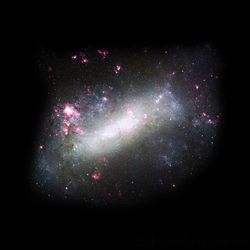

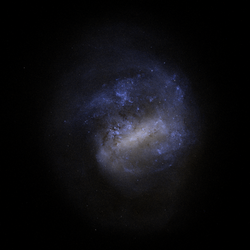
![Revisiting a Celestial Fireworks Display Shreds, from the Wide Field Planetary Camera 2. The delicate sheets and intricate filaments are debris from the cataclysmic death of a massive star that once lived in the LMC.[58]](http://upload.wikimedia.org/wikipedia/commons/thumb/9/9e/Revisiting_a_Celestial_Fireworks_Display_%28potw2248a%29.jpg/250px-Revisiting_a_Celestial_Fireworks_Display_%28potw2248a%29.jpg)
![DEM L316A is located some 160,000 light-years away in the Large Magellanic Cloud[59]](http://upload.wikimedia.org/wikipedia/commons/thumb/8/89/A_long-dead_star_DEM_L316A.jpg/250px-A_long-dead_star_DEM_L316A.jpg)
